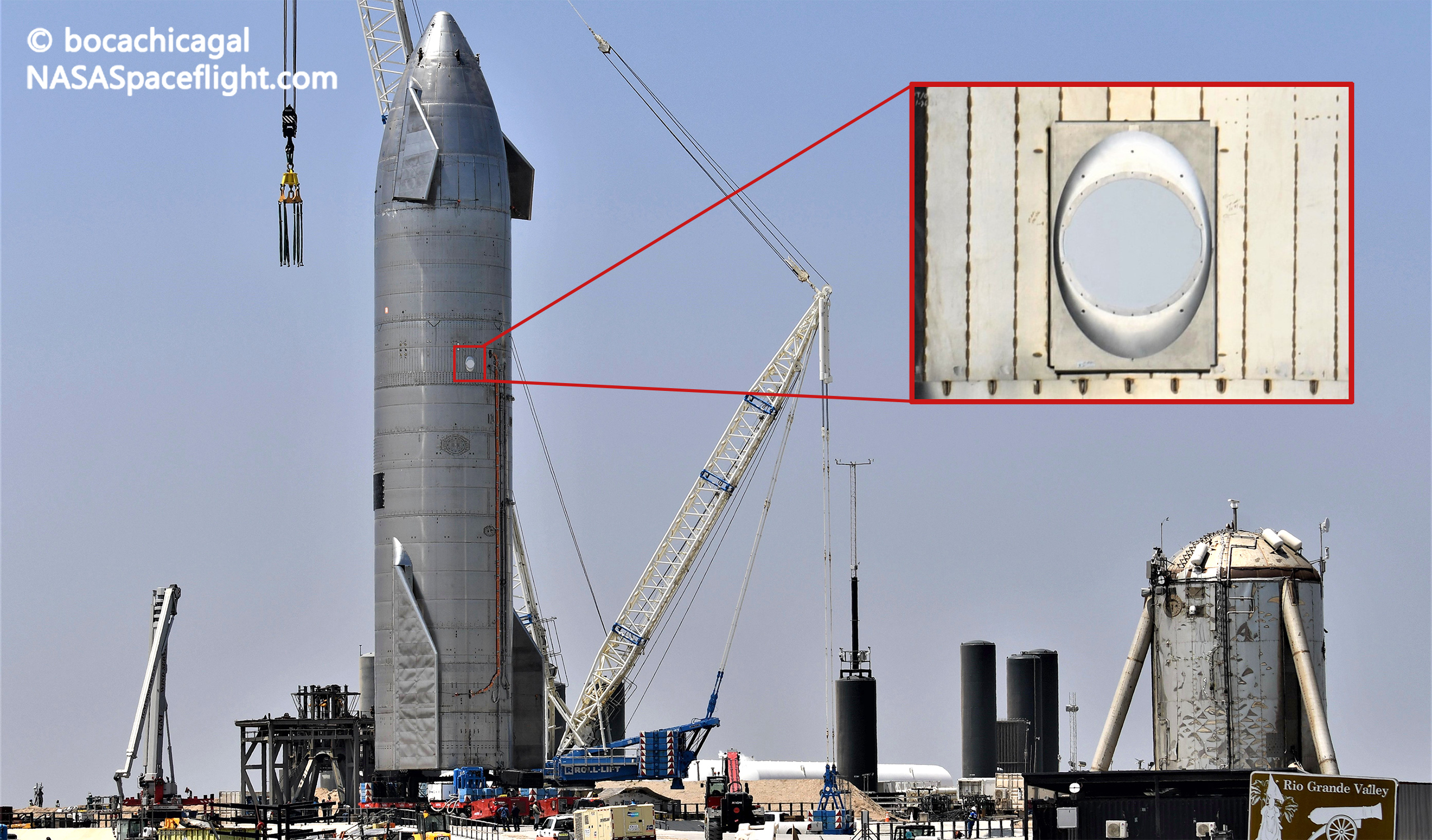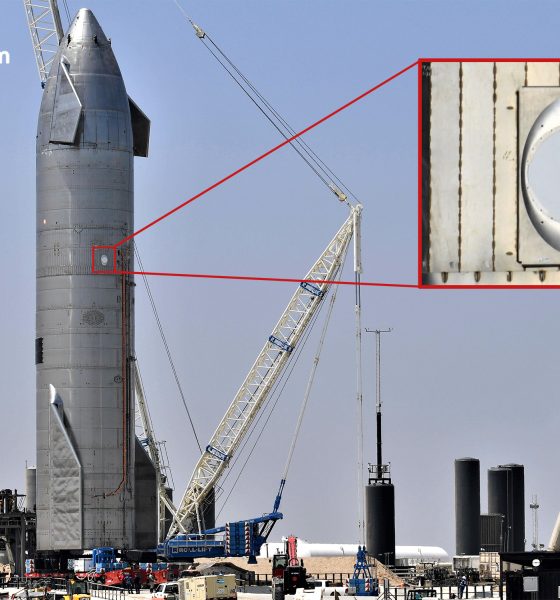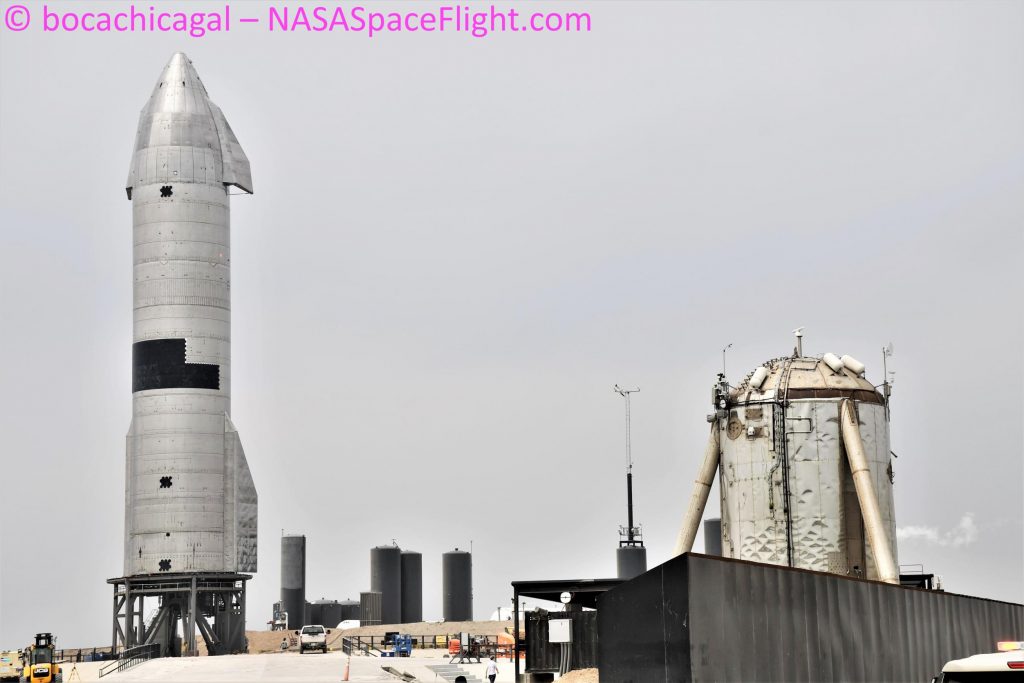

News
SpaceX installs Starlink dish on upgraded Starship prototype
In the latest in a long line of twists, SpaceX has requested permission from the FCC to operate a Starlink internet antenna installed on Starship serial number 15 (SN15).
The first in a planned batch of four or more upgraded Starship prototypes, SN15 was rolled a mile down the road from SpaceX’s South Texas factory to its suborbital launch pad late last week. Around the same time that its aft tank section was being prepped for nose installation on April 3rd, some of the first 360-degree views of the rocket revealed an unusual porthole-esque addition just above the Starship’s forward tank dome. As far back as Starhopper in 2019, Starships have used that space between tank and nosecone as an installation point for avionics, Tesla batteries, and a number of radio and GPS antennas, among other things.
The new hardware generally fell under the radar but most that took note assumed it was some kind of antenna upgrade. As it turns out, that speculation was almost certainly correct – but not in the way most expected.

When SN15’s new antenna first appeared, the author speculated that it bore a striking resemblance to a SpaceX Starlink dish. However, another forum user argued that it was more likely an upgraded S-band antenna akin to those used on SpaceX’s Falcon rockets. The author later noted that the S-band antenna pass-through located on the interstage of Falcon boosters was almost the same size as the new antenna and shroud visible on Starship SN15, seemingly closing the case.

Nine days later, SpaceX asked the FCC for permission to operate a Starlink dish (user terminal) in Boca Chica “at altitudes not to exceed 12.5 km” during operations “on the ground or during test flights.” In other words, the antenna installed on Starship SN15 is almost certainly a Starlink dish. Surrounded by an aerodynamic shroud, the antenna is firmly fixed on the rocket and would rely entirely upon cutting-edge phased array beamforming to electronically ‘steer’ itself to both transmit and receive from one or more of almost a thousand operational Starlink satellites currently in orbit.
In SpaceX’s FCC Special Temporary Authority (STA) request, the company curiously asked for the 60-day test period to begin on April 20th. Even if the FCC moves extremely quickly and grants the STA within a few days to a week of SpaceX’s April 9th request, it’s unlikely that the company would delay Starship SN15 test or launch plans by almost ten days to wait for permission to use the rocket’s new Starlink antenna. In other words, while SN15 is the first Starship to have a Starlink antenna installed, there’s a decent chance it won’t be the first to actually put that capability to the test – both on the ground or during a launch.
While unlikely, the fact that SpaceX’s Starship SN15 Starlink antenna installation is almost the same size as Falcon 9’s reliable but far more basic S-band setup also begs the question of whether success on Starship test flights could eventually lead to the addition of Starlink dishes on future Falcon boosters. Regardless, Starship SN15 is on track to kick off a busy week of qualification testing in South Texas. If the rocket suffers any significant delays, as has admittedly been the norm for Starship prototypes, there’s a good chance SN15 could begin testing its Starlink dish around the middle of next week.

Elon Musk
Elon Musk and Tesla AI Director share insights after empty driver seat Robotaxi rides
The executives’ unoccupied tests hint at the rapid progress of Tesla’s unsupervised Robotaxi efforts.

Tesla CEO Elon Musk and AI Director Ashok Elluswamy celebrated Christmas Eve by sharing personal experiences with Robotaxi vehicles that had no safety monitor or occupant in the driver’s seat. Musk described the system’s “perfect driving” around Austin, while Elluswamy posted video from the back seat, calling it “an amazing experience.”
The executives’ unoccupied tests hint at the rapid progress of Tesla’s unsupervised Robotaxi efforts.
Elon and Ashok’s firsthand Robotaxi insights
Prior to Musk and the Tesla AI Director’s posts, sightings of unmanned Teslas navigating public roads were widely shared on social media. One such vehicle was spotted in Austin, Texas, which Elon Musk acknowleged by stating that “Testing is underway with no occupants in the car.”
Based on his Christmas Eve post, Musk seemed to have tested an unmanned Tesla himself. “A Tesla with no safety monitor in the car and me sitting in the passenger seat took me all around Austin on Sunday with perfect driving,” Musk wrote in his post.
Elluswamy responded with a 2-minute video showing himself in the rear of an unmanned Tesla. The video featured the vehicle’s empty front seats, as well as its smooth handling through real-world traffic. He captioned his video with the words, “It’s an amazing experience!”
Towards Unsupervised operations
During an xAI Hackathon earlier this month, Elon Musk mentioned that Tesla owed be removing Safety Monitors from its Robotaxis in Austin in just three weeks. “Unsupervised is pretty much solved at this point. So there will be Tesla Robotaxis operating in Austin with no one in them. Not even anyone in the passenger seat in about three weeks,” he said. Musk echoed similar estimates at the 2025 Annual Shareholder Meeting and the Q3 2025 earnings call.
Considering the insights that were posted Musk and Elluswamy, it does appear that Tesla is working hard towards operating its Robotaxis with no safety monitors. This is quite impressive considering that the service was launched just earlier this year.
Elon Musk
Starlink passes 9 million active customers just weeks after hitting 8 million
The milestone highlights the accelerating growth of Starlink, which has now been adding over 20,000 new users per day.

SpaceX’s Starlink satellite internet service has continued its rapid global expansion, surpassing 9 million active customers just weeks after crossing the 8 million mark.
The milestone highlights the accelerating growth of Starlink, which has now been adding over 20,000 new users per day.
9 million customers
In a post on X, SpaceX stated that Starlink now serves over 9 million active users across 155 countries, territories, and markets. The company reached 8 million customers in early November, meaning it added roughly 1 million subscribers in under seven weeks, or about 21,275 new users on average per day.
“Starlink is connecting more than 9M active customers with high-speed internet across 155 countries, territories, and many other markets,” Starlink wrote in a post on its official X account. SpaceX President Gwynne Shotwell also celebrated the milestone on X. “A huge thank you to all of our customers and congrats to the Starlink team for such an incredible product,” she wrote.
That growth rate reflects both rising demand for broadband in underserved regions and Starlink’s expanding satellite constellation, which now includes more than 9,000 low-Earth-orbit satellites designed to deliver high-speed, low-latency internet worldwide.
Starlink’s momentum
Starlink’s momentum has been building up. SpaceX reported 4.6 million Starlink customers in December 2024, followed by 7 million by August 2025, and 8 million customers in November. Independent data also suggests Starlink usage is rising sharply, with Cloudflare reporting that global web traffic from Starlink users more than doubled in 2025, as noted in an Insider report.
Starlink’s momentum is increasingly tied to SpaceX’s broader financial outlook. Elon Musk has said the satellite network is “by far” the company’s largest revenue driver, and reports suggest SpaceX may be positioning itself for an initial public offering as soon as next year, with valuations estimated as high as $1.5 trillion. Musk has also suggested in the past that Starlink could have its own IPO in the future.
News
NVIDIA Director of Robotics: Tesla FSD v14 is the first AI to pass the “Physical Turing Test”
After testing FSD v14, Fan stated that his experience with FSD felt magical at first, but it soon started to feel like a routine.

NVIDIA Director of Robotics Jim Fan has praised Tesla’s Full Self-Driving (Supervised) v14 as the first AI to pass what he described as a “Physical Turing Test.”
After testing FSD v14, Fan stated that his experience with FSD felt magical at first, but it soon started to feel like a routine. And just like smartphones today, removing it now would “actively hurt.”
Jim Fan’s hands-on FSD v14 impressions
Fan, a leading researcher in embodied AI who is currently solving Physical AI at NVIDIA and spearheading the company’s Project GR00T initiative, noted that he actually was late to the Tesla game. He was, however, one of the first to try out FSD v14.
“I was very late to own a Tesla but among the earliest to try out FSD v14. It’s perhaps the first time I experience an AI that passes the Physical Turing Test: after a long day at work, you press a button, lay back, and couldn’t tell if a neural net or a human drove you home,” Fan wrote in a post on X.
Fan added: “Despite knowing exactly how robot learning works, I still find it magical watching the steering wheel turn by itself. First it feels surreal, next it becomes routine. Then, like the smartphone, taking it away actively hurts. This is how humanity gets rewired and glued to god-like technologies.”
The Physical Turing Test
The original Turing Test was conceived by Alan Turing in 1950, and it was aimed at determining if a machine could exhibit behavior that is equivalent to or indistinguishable from a human. By focusing on text-based conversations, the original Turing Test set a high bar for natural language processing and machine learning.
This test has been passed by today’s large language models. However, the capability to converse in a humanlike manner is a completely different challenge from performing real-world problem-solving or physical interactions. Thus, Fan introduced the Physical Turing Test, which challenges AI systems to demonstrate intelligence through physical actions.
Based on Fan’s comments, Tesla has demonstrated these intelligent physical actions with FSD v14. Elon Musk agreed with the NVIDIA executive, stating in a post on X that with FSD v14, “you can sense the sentience maturing.” Musk also praised Tesla AI, calling it the best “real-world AI” today.








